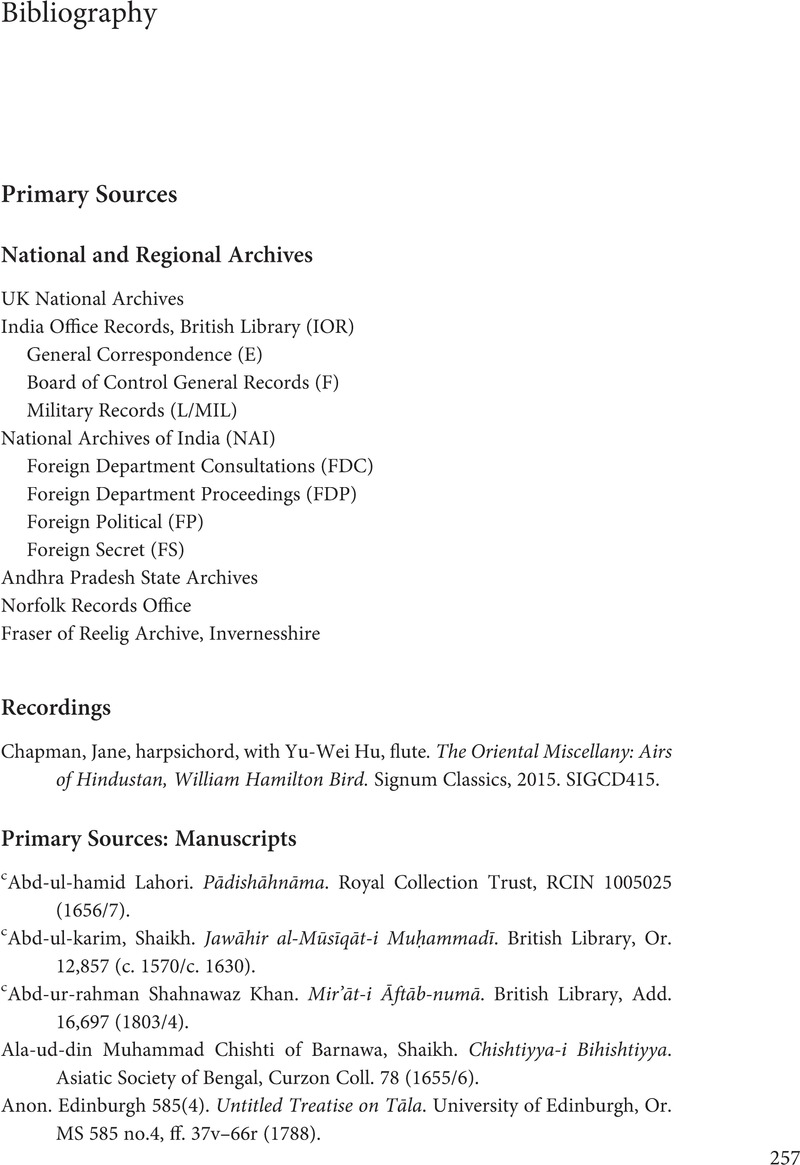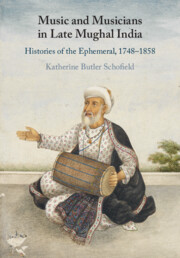Book contents
- Music and Musicians in Late Mughal India
- Music and Musicians in Late Mughal India
- Copyright page
- Dedication
- Contents
- Figures
- Tables
- Boxes
- Examples
- Acknowledgements
- Notes on the Text
- Additional material
- Ruling Dynasties*
- Genealogies of Principal Musicians and Music Treatises
- Additional material
- 1 Chasing Eurydice
- 2 The Mughal Orpheus: Remembering Khushhal Khan Gunasamudra in Eighteenth-Century Delhi
- 3 The Rivals: Anjha Baras, Adarang and the Scattering of Shahjahanabad
- 4 The Courtesan and the Memsahib: Khanum Jan and Sophia Plowden at the Court of Lucknow
- 5 Eclipsed by the Moon: Mahlaqa Bai and Khushhal Khan Anup in Nizami Hyderabad
- 6 Faithful to the Salt: Mayalee Dancing Girl versus the East India Company in Rajasthan
- 7 Keeper of the Flame: Miyan Himmat Khan and the Last of the Mughal Emperors
- 8 Orphans of the Uprising: Late Mughal Echoes and 1857
- Glossary
- Bibliography
- Tazkira: List of Names
- Index
- References
Bibliography
Published online by Cambridge University Press: 09 November 2023
- Music and Musicians in Late Mughal India
- Music and Musicians in Late Mughal India
- Copyright page
- Dedication
- Contents
- Figures
- Tables
- Boxes
- Examples
- Acknowledgements
- Notes on the Text
- Additional material
- Ruling Dynasties*
- Genealogies of Principal Musicians and Music Treatises
- Additional material
- 1 Chasing Eurydice
- 2 The Mughal Orpheus: Remembering Khushhal Khan Gunasamudra in Eighteenth-Century Delhi
- 3 The Rivals: Anjha Baras, Adarang and the Scattering of Shahjahanabad
- 4 The Courtesan and the Memsahib: Khanum Jan and Sophia Plowden at the Court of Lucknow
- 5 Eclipsed by the Moon: Mahlaqa Bai and Khushhal Khan Anup in Nizami Hyderabad
- 6 Faithful to the Salt: Mayalee Dancing Girl versus the East India Company in Rajasthan
- 7 Keeper of the Flame: Miyan Himmat Khan and the Last of the Mughal Emperors
- 8 Orphans of the Uprising: Late Mughal Echoes and 1857
- Glossary
- Bibliography
- Tazkira: List of Names
- Index
- References
Summary

- Type
- Chapter
- Information
- Music and Musicians in Late Mughal IndiaHistories of the Ephemeral, 1748–1858, pp. 257 - 284Publisher: Cambridge University PressPrint publication year: 2023

